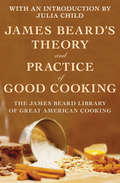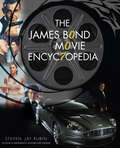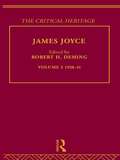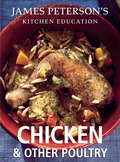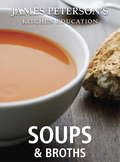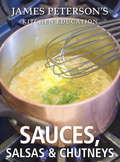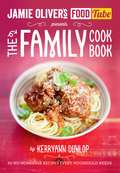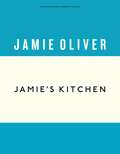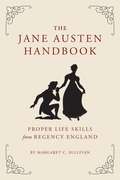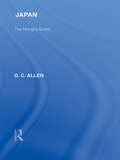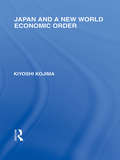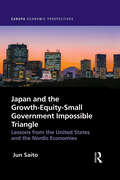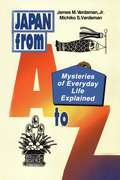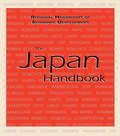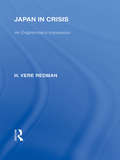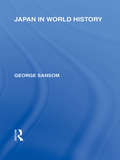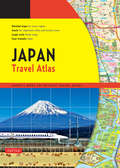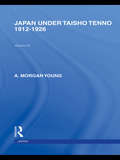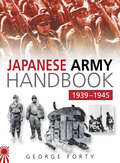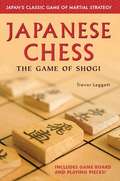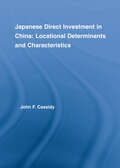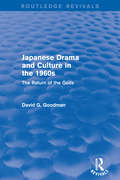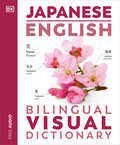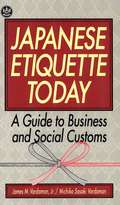- Table View
- List View
James Beard's Theory and Practice of Good Cooking
by Julia Child James BeardFather of American gastronomy James Beard shares his extensive knowledge of all things culinary in this essential guide "In my twenty-five years of teaching I have tried to make people realize that cooking is primarily fun and that the more they know about what they are doing, the more fun it is." So begins James Beard's expansive book of culinary terms, methods, tools, and techniques. No one knew food better than Beard, and in these pages his timeless wisdom is on full display. Perfect for both seasoned chefs and those just starting out in the kitchen, James Beard's Theory and Practice of Good Cooking will be one of the most comprehensive and important cookbooks in your library. With a guide to kitchenware, step-by-step explanations of foundational cooking techniques, and more than 300 classic recipes to add to your repertoire, this invaluable volume provides all you need to become a star in the kitchen. Beard's dishes, from poached pears to steak au poivre, stuffed clams to chocolate soufflé, will delight the senses. And his unpretentious advice, alongside personal anecdotes and food histories, will make cooking a joy.
The James Bond Movie Encyclopedia
by Steven Jay RubinIan Fleming's James Bond character has entertained motion picture audiences for nearly sixty years, and the filmmakers have come a long way since they spent $1 million producing the very first James Bond movie, Dr. No, in 1962. The 2015 Bond title, Spectre, cost $250 million and grossed $881 million worldwide—and 2020's No Time to Die is certain to become another global blockbuster. The James Bond Movie Encyclopediais the completely up-to-date edition of author Steven Jay Rubin's seminal work on the James Bond film series. It covers the entire series through No Time to Die. Packed with behind-the-scenes information based on interviews with the cast and filmmakers, fascinating facts, trivia, bloopers, classic quotes, character bios, and cast and filmmaker bios, it showcases the type of exhaustive research that has been a hallmark of Rubin's work in film history. It also features hundreds of rare and unusual still photographs of the participants both in front of and behind the camera.
James Joyce. Volume 2: 1928-41
by Robert H. DemingThis set comprises 40 volumes covering nineteenth and twentieth century European and American authors. These volumes will be available as a complete set, mini boxed sets (by theme) or as individual volumes. This second set compliments the first 68 volume set of Critical Heritage published by Routledge in October 1995.
James Peterson's Kitchen Education: Chicken and Other Poultry
by James PetersonCelebrated chef, teacher, and cookbook author James Peterson presents more than thirty recipes for chicken, turkey, duck, squab, and quail from Cooking, his classic guide for home cooks. Featuring delicious and approachable recipes for all manner of poultry and birds, such as Moroccan Chicken Tagine, Provençal Chicken, classic Roast Turkey, Duck Confit, and more, Peterson teaches the finer points of cooking to produce consistently excellent results. He also includes an array of helpful step-by-step photographs to help you master the techniques and build confidence in the kitchen. In addition to the wonderful and diverse recipes, Peterson provides a true kitchen education, with sections on the ten basic cooking methods, techniques all cooks should know, cooking terms, and recommended ingredients and kitchen tools. This e-book exclusive is an enriching addition to anyone's digital library, and cooks both new and experienced will appreciate Peterson's relaxed, unfussy style that encourages them to learn, keep it simple, and have fun in the kitchen. Be sure to check out more e-book exclusives from James Peterson's Kitchen Education series.
James Peterson's Kitchen Education: Soups and Broths
by James PetersonCelebrated chef, teacher, and cookbook author James Peterson presents more than forty soup and broth recipes from Cooking, his classic guide for home cooks. Within, cooks of all levels will find a wide variety of delicious, doable recipes: basics like chicken broth, classics like Tomato Soup, and exotics such as Thai Hot-and-Spicy Shrimp Soup. For those looking to get creative, Peterson explains soup fundamentals so you can craft your own dishes tailored to different palates and tastes. Peterson also includes an array of helpful step-by-step photographs to help you master the techniques and build confidence in the kitchen. In addition to the wonderful and diverse recipes, Peterson provides a true kitchen education, with sections on the ten basic cooking methods, recipes and techniques all cooks should know, cooking terms, and recommended ingredients and kitchen tools. This e-book exclusive is an enriching addition to anyone's digital library, and cooks both new and experienced will appreciate Peterson's relaxed, unfussy style that encourages them to learn, keep it simple, and have fun in the kitchen. Be sure to check out more e-book exclusives from James Peterson's Kitchen Education series.
James Peterson's Kitchen Education: Sauces, Salsas, and Chutneys
by James PetersonCelebrated chef, teacher, and cookbook author James Peterson presents more than fifty recipes for sauces, salsas, and chutneys from Cooking, his classic guide for home cooks. Covering a comprehensive range of sauces--including Bordelaise, Pesto, Rouille, Barbecue, Ponzu, Tropical Fruit Salsa, and more--Peterson teaches the fundamentals of making delicious and approachable sauces that will enhance your kitchen repertoire. These versatile recipes punch up any dish, including meat, fish, pasta, sandwiches, and vegetables. Peterson also includes an array of helpful step-by-step photographs to help you master the techniques and build confidence in the kitchen.In addition to the wonderful and diverse recipes, Peterson provides a true kitchen education, with sections on the ten basic cooking methods, recipes and techniques all cooks should know, cooking terms, and recommended ingredients and kitchen tools. This e-book exclusive is an enriching addition to anyone's digital library, and cooks both new and experienced will appreciate Peterson's relaxed, unfussy style that encourages them to learn, keep it simple, and have fun in the kitchen.Be sure to check out more e-book exclusives from James Peterson's Kitchen Education series.
Jamie's Food Tube: The Family Cookbook
by Kerryann DunlopJamie Oliver's Food Tube presents The Family Cookbook, packed with 50 wholesome, hearty and everyday recipes to please the whole family'Kerryann is a big character with a tone and style that's warm, motherly and gentle - with these recipes and her thrifty family tips and tricks, you'll have a bunch of recipes that'll serve you well for years to come' Jamie OliverKerryann's no-nonsense approach to creating comforting family meals show that it's not hard to eat delicious food on a tight budget.She also has plenty of tips and tricks to get the most out of simple ingredients, making The Family Cookbook a staple in any home.Her no-fuss recipes for delicious family classics include:- PANCAKES and BERRY COMPOTE- EASY CHICKEN CURRY- HOMEMADE FISH FINGERS and MINTY SMASHED PEAS- POTATO, CHICKPEA and CAULIFLOWER CURRY- LAMB CHOPS with AUBERGINE SALADRevolutionise your family cooking with The Family Cookbook, using simple and scrumptious recipes that will get the whole family involved.
Jamie's Kitchen (Anniversary Editions #4)
by Jamie Oliver'Jamie should be given the Victoria Cross' The TimesWith over 100 delicious recipes, Jamie shows that anyone can learn to cook beautiful food based on simple principles and techniques.Divided into chapters on different techniques: Cracking Salads, Cooking without Heat, Poaching & Boiling, Steaming & Cooking in the Bag, Stewing & Braising, Frying, Roasting, Pot-roasting & Pan-roasting, Grilling & Chargrilling and Baking & Sweet Things, you'll soon be cooking up a storm. Jamie also gives you advice on kitchen kit and shopping tips.Simple but tasty recipes include: · Warm SALAD of ROASTED SQUASH, PROSCIUTTO and PECORINO · CITRUS-SEARED TUNA with CRISPY NOODLES, HERBS and CHILLI· PAPPARDELLE PASTA with AMAZING SLOW COOKED MEAT · LEBANESE LEMON CHICKEN· BAILEYS and BANANA BREAD & BUTTER PUDDING'Jamie offers lots of his chunky, hunky dishes for feeding the hungry, and lathers the whole lot with ladlefuls of encouragement' Daily Telegraph___________Celebrating the 20th anniversary of The Naked Chef Penguin are re-releasing Jamie's first five cookbooks as beautiful Hardback Anniversary Editions - an essential for every kitchen. The Naked ChefThe Return of the Naked ChefHappy Days with the Naked ChefJamie's KitchenJamie's Dinners'20 years on . . . Does it stand the test of my kitchen? The answer is a resounding yes. Jamie's genius is in creating maximum flavour from quick, easy-to-follow recipes . . . It hasn't dated at all' Daily Telegraph on The Naked Chef_____________
The Jane Austen Handbook: Proper Life Skills from Regency England
by Margaret SullivanLong before Pride and Prejudice and Zombies, Quirk published this guide to life in Regency England to the delight of Austen fans everywhere. Newly published with a revised cover, The Jane Austen Handbook offers step-by-step instructions for proper comportment in the early 19th century. Readers will discover: * How to Indicate Interest in a Gentleman Without Seeming Forward * How to Ensure a Good Yearly Income * How to Ride Sidesaddle * How to Behave at a Dinner PartyFull of practical directions for navigating the travails of Regency life, this charming illustrated book also serves as a companion for present-day readers, explaining the English class system, currency, dress, and the nuances of graceful living.
Japan: The Hungry Guest
by G C AllenWritten after the outbreak of war between Japan and China but putting aside British sentiments of suspicion, dislike and a sense of competition, G C Allen bases his observations of Japanese social, political and economic life on his first-hand experience of living and working in the country for a number of years. He argues that the economic expansion of Japan was regarded as a greater threat to Britain because of Japan’s political aims and aggressive territorial expansion, but he is at pains to explain the Japanese domestic circumstances which gave rise to this situation. He also argues that the expansion of the British Empire has some parallels with Japanese expansion, without condoning Japanese methods. Overall the author emphasizes the extent to which judgments about the qualities of the Japanese people have been influenced by the political views of writers in Western countries.
Japan and a New World Economic Order (Routledge Library Editions: Japan)
by Kyoshi KojimaPresident Nixon’s new economic policy of August 1971, aggravated by the oil problem since October 1973 caused chaos and uncertainty in the international trade and currency system. There were fears of another 1930s style depression. In addition, a world food shortage and strident claims by developing countries for perpetual sovereignty over resources added another set of difficulties. This volume, written from Japan’s standpoint, suggests a new direction for the world and regional economic order. The book tackles two major issues in international economics: Firstly, traditional international trade theory aims only at static maximization in the use of world human and material resources, but, the author stresses more attention should be paid to such dynamic or developmental elements as population growth, immigration, natural resource development, improvement in transfer of technology, economies of scale, direct foreign investment and economic integration in order to create development centres or sectors in the world economy. Secondly, the author discusses how to combine a global and regional approach to economic integration.
Japan and the Growth-Equity-Small Government Impossible Triangle: Lessons from the United States and the Nordic Economies (Europa Economic Perspectives)
by Jun SaitoThis volume examines and analyzes the current situation of, and the future prospects for, the Japanese economy, particularly in the context of inequality. The country's economy is facing the ageing and the shrinking of its population, both of which will reduce the potential growth rate, which has already become very low. By introducing a new policy framework, namely the `Equity-Growth-Small Government Impossible Triangle', based on reviewing, comparing and contrasting the policies of the United States, the Nordic economies and Japan, the book proposes a policy direction that could be pursued by Japan. If Japan wants to sustain growth while preventing inequality to widen and preserve an egalitarian society, there is no other choice but to further promote globalization and innovation and, at the same time, surrender preserving a small government by reforming itself to become a dynamic and resilient welfare state. The volume will be an invaluable resource for students, professionals and researchers with an interest in economics, inequality, the Japanese economy and comparative economic policies.
Japan from A to Z: Mysteries of Everyday Life Explained
by Michiko Sasaki Vardaman James M. VardamanThis Japanese travel guide provides goes beyond the typical guidebook, revealing the underlying cultural and historical reasons for the behavior and attitudes of The Japanese.<P><P>Authors Michiko and James Vardaman identify nearly three hundred aspects of Japanese culture, custom, and daily life that commonly frustrate, delight, or just plain stump non-Japanese. For each topic, they provide historical and other background that helps strip away some of the mystery surrounding Japanese culture, and make inscrutable Japan a little more scrutable. Drawings and illustrations help illustrate some objects that may be unfamiliar to Westerns, such as "New Year's rakes," Japanese water sprites, and wish tablets.Japan from A to Z fills in holes left by more academically oriented books on Japan by providing information on topics that readers would be unable to find in more staid, conventional sources. Fun and fascinating for tourist and resident alike, it offers a concise, readable introduction to the country and its way of life.
The Japan Handbook (Regional Handbooks of Economic Development #Vol. 3)
by Patrick HeenanFirst Published in 1999. Routledge is an imprint of Taylor & Francis, an informa company.
Japan in Crisis: An Englishman's Impression (Routledge Library Editions: Japan)
by Hugh Vere Redman"...The Japanese are not so black as they are painted or so immaculate as they occasionally paint themselves." As the author’s own words suggest, this book attempts to give a balanced account of Japan during the "crisis" years of 1931-1935 which were some of the most significant in modern Japanese history. They saw an act of political expansion unique in the years following World War One, as well as an expansion of Japanese foreign trade in markets hitherto dominated by the exports of other countries. The letters re-issued here were written for both the Western and Japanese reader and as such represent an unrivalled impartial resource.
Japan in World History (Routledge Library Editions: Japan)
by George SansomIn this volume the author considers what the purpose and method of advanced Japanese studies should be. He believes that the study of Japanese history should be, not an end in itself but an integral part of world history. He discusses areas of controversy in interpretation which arise when a comparative method is used and Japanese history is examined in correlation with world history.
Japan Travel Atlas
by Tuttle PublishingFinding your way around Japan is a breeze with this handy Tuttle travel atlas. Designed for the adventurous traveler and containing all the maps you'll need on your explorations, this atlas includes many views and insets not available elsewhere.<P><P>The perfect travel guide, this atlas is conveniently divided into chapters covering the major regions of Japan, including Tokyo, Mt. Fuji and around Tokyo, Central Honshu, Kyoto, Kansai, Hiroshima and Western Honshu, Northern Honshu, Hokkaido, Shikoku, Kyushu, and Okinawa & the Southwest Islands. Each of the 148 maps in this atlas are easy-to-follow and are presented in a logical manner. Emphasis is placed on the most frequently-visited areas, and all cities, towns, villages and places of interest are indexed for quick reference..All roads are color-coded with major arteries in bright yellow and orange. All key landmarks are highlighted-including airports, beaches, temples, hotels, shops, restaurants, shopping malls, consulates, government offices, hospitals, clinics, police stations, schools, parks, banks, golf courses and more!Maps are shown at various scales, but are large enough to see details. User-friendly indexes at the back list all streets, towns, villages and buildings for quick reference.COMPREHENSIVE: Covers every major town and tourist area in Japan.INFORMATIVE: Gives precise locations of popular sights, including hotels, restaurants, temples, shopping malls and other essential landmarks.PRACTICAL: The handy size, well-designed key maps and comprehensive indexes help you find your destination quickly.RELIABLE: The maps in this atlas are thoroughly researched and regularly updated by Tuttle Publishing-the leading publisher of Asia Pacific maps.
Japan Under Taisho Tenno: 1912-1926 (Routledge Library Editions: Japan)
by A Morgan YoungA journalist on the Japan Chronicle for eleven years this volume examines the history, economy, politics and society of Japan from just before the First World War until 1926. Japan’s relations with the West, as well as with Russia and China are also discussed.
Japanese Army Handbook 1939-1945: 1939-1945
by George FortyThis is an insight into the most feared army of World War II. The Japanese Imperial Army grew from 1.5 million men in 1939 to 5.5 million men by the end of the war. Their highly successful campaigns in the Far East and the Pacific at the beginning of World War II were every bit as spectacular as those of the Germans in Europe, and they earned an enviable reputation as expert jungle fighters which it took some years for the Allies to match. Their code of honour also made them extremely cruel enemies to prisoners and civilians alike, while their Kamikaze suicidal tendencies meant they would automatically fight to the last without any thought of surrender. Fully illustrated with rare archive photographs, this is a comprehensive study of the army. The author describes how they mobilized and trained their soldiers, and looks at their organizational structures, from high command down to divisional level and below. Also included are uniforms, equipment, all kinds of weapons ranging from tanks and artillery, technical equipment, tactics, symbology and vehicle markings.
Japanese Chess
by Alan Baker Trevor LeggettThe ancient game of chess has its roots in India, where the legendary emperor Ravana used it to exercise his generals in strategy and tactics. Played by millions around the world, shogi is the uniquely Japanese variant of chess.Japanese Chess is the ultimate book on shogi for beginners and experienced players alike. Its step-by-step instructions and easy-to-follow diagrams lead the reader through the strategies and intricacies of one of Japan's most popular board games. Shogi is the only variation of chess in which an opponent's captured piece can be dropped back onto the board as one's own. This makes for extremely exciting, dynamic game play in which momentum can quickly shift back and forth between players.This essential resource includes a shogi board bound right into it, folding out for use with the included shogi pieces.
Japanese Chess
by Trevor Leggett Alan BakerThe ancient game of chess has its roots in India, where the legendary emperor Ravana used it to exercise his generals in strategy and tactics. Played by millions around the world, shogi is the uniquely Japanese variant of chess.Japanese Chess is the ultimate book on shogi for beginners and experienced players alike. Its step-by-step instructions and easy-to-follow diagrams lead the reader through the strategies and intricacies of one of Japan's most popular board games. Shogi is the only variation of chess in which an opponent's captured piece can be dropped back onto the board as one's own. This makes for extremely exciting, dynamic game play in which momentum can quickly shift back and forth between players.This essential resource includes a shogi board bound right into it, folding out for use with the included shogi pieces.
Japanese Direct Investment in China: Locational Determinants and Characteristics
by John F. CassidyChina, with the world's largest population, is set to become the second largest market in the world by 2010. The importance of understanding the environment for foreign direct investment (FDI) in China has never been more apparent. With this as a context, this book examines FDI in China with the emphasis on the 'where to locate' question. Japanese direct investment is used as a case study elucidating the key locational determinants and characteristics thereof. This is the first book focusing on the 'where to locate' question with respect to the China market. All companies with a China strategy and all university business departments will find this book of vital importance.
Japanese Drama and Culture in the 1960s: The Return of the Gods (Routledge Revivals)
by D.G. GoodmanThis title was first published in 1988: In this book the author has translated five postwar experimental Japanese plays and recreated the artistic, social and spiritual milieu in which they were created. He describes the turning point in Japanese thinking about the nature and limitations of a Western-oriented modern culture, and the creation of "underground" theatres which in which evolved a new mythology of history. Professor Goodman sees these developments as an interplay between personal and political (ie revolutionary) salvation.
Japanese - English Bilingual Visual Dictionary (DK Bilingual Visual Dictionaries)
by DKWith more than 6,750 fully illustrated words and phrases in Japanese and English, along with a free bilingual audio app, DK's Japanese-English Bilingual Visual Dictionary is your essential companion to life in any Japanese-speaking country.You will learn all the words and phrases you need to buy food and clothes, talk about work and education, visit the doctor, go to the bank, use public transportation, and much more. Perfect for tourists, business travelers, and students, the dictionary is incredibly easy to follow, with thematically organized vocabulary so you can find closely related words on a particular topic. Words and phrases are illustrated with full-color photographs and artwork, helping to fix new vocabulary in your mind. A comprehensive, two-way index provides an instant reference point for new Japanese vocabulary.The supporting audio app enables you to hear all the words and phrases spoken out loud in Japanese. The app is easy to use and helps you learn, remember, and pronounce important vocabulary. The dictionary gives a pronunciation guide for every Japanese word, and you can use this alongside the app to perfect your pronunciation.
Japanese Etiquette Today
by Michiko Sasaki Vardaman James M. VardamanJapan today "looks" more and more Western, principles governing social and business relations become harder to see. Most foreigners know that Japanese etiquette differs from that of other countries, but few people know the extent of the differences. It is this diversity that first attracted the authors of Japanese Etiquette Today, a book written to make working and living in Japan enjoyable and rewarding experiences.The authors look at a variety of formal and informal occasions governed by subtle rules-visiting a Japanese office and h ome, giving and returning gifts, attending weddings and funerals, and much more. The result is an informal overview of Japanese society and a manual of practical advice on getting a long in that society. Complete with essential vocabulary and phrases, this handy guidebook explains what to do and perhaps more important what not to do, what to say, what to wear, indeed, whatever you need to observe the complex rules of modern Japanese etiquette.
